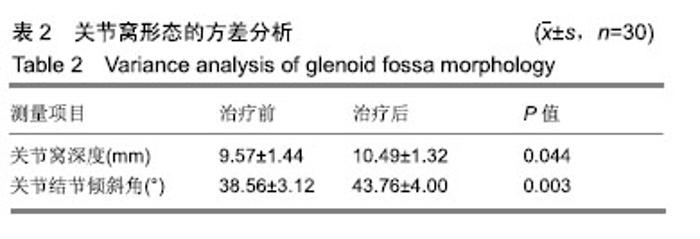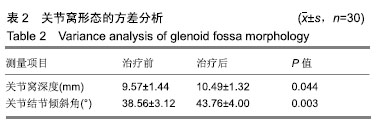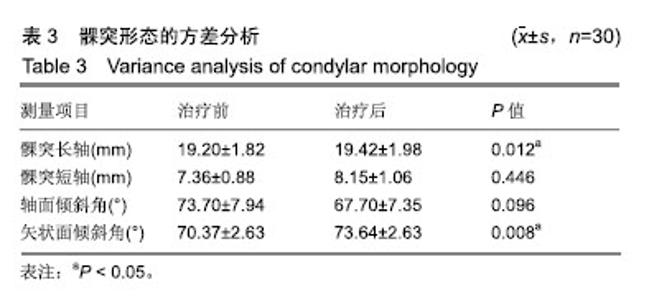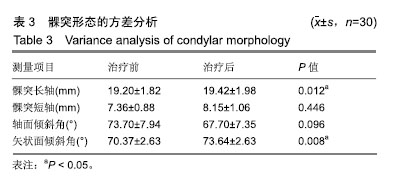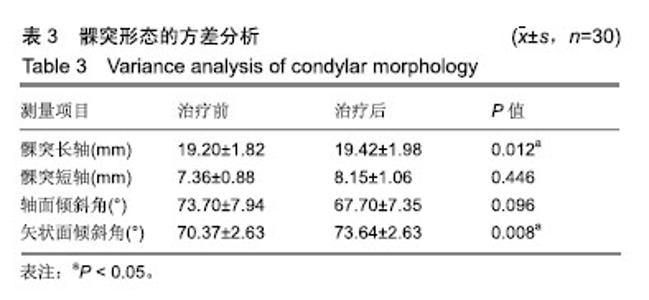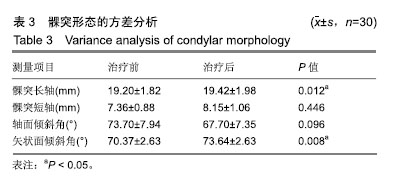| [1]郭向红,丁寅,房伟,等.不同矢状骨面型颞下颌关节窝位置的测量研究[J].临床口腔医学杂志, 2007,23(5):275-277.[2]柳汀.不同矢状骨面型高角错牙合畸形患者颞下颌关节的CBCT研究[D].天津:天津医科大学, 2017.[3]Kurusu A,Horiuchi M,Soma K.Relationship between occlusal force and mandibular condyle morphology. Evaluated by limited cone-beam computed tomography.Angle Orthod. 2009;79(6):1063-1069.[4]Yu J, Hu Y, Huang M, et al.A three-dimensional analysis of skeletal and dental characteristics in skeletal class III patients with facial asymmetry.J Xray Sci Technol.2018;26(3):449-462.[5]孟娟红,张万林,柳登高,等.牙颌面锥形束CT与普通X线检查对颞下颌关节骨关节病诊断价值的比较研究[J].北京大学学报(医学版), 2007,39(1):26-29.[6]Markic G,Muller L,Patcas R, et al.Assessing the length of the mandibular ramus and the condylar process: a comparison of OPG, CBCT, CT, MRI, and lateral cephalometric measurements. Eur J Orthod. 2015,37(1):13-21.[7]王照五,石校伟,姜华,等.牙颌专用CT的颞颌关节成像技术[J].中国医学影像学杂志, 2006,14(6):444-447.[8]杨鑫,王大为,韩剑丽,等.Ⅲ类骨面型错牙合患者颞下颌关节CBCT测量分析[J].中国美容医学杂志, 2014,23(16):1372-1377.[9]曲冠霖,张丹,杨鸣良,等.骨性Ⅲ类偏颌患者下颌骨髁突位置三维评估研究[J].中国实用口腔科杂志, 2018,11(3):167-171.[10]陆兴龙,杨建浩,张志伟,等.成人AngleⅠ?AngleⅡ~1和AngleⅡ~ 2类错牙合畸形髁突形态和位置的CBCT对比研究[J].口腔医学研究, 2018,34(3):286-289.[11]刘冬梅,程锦,李永刚,等.特发性髁突吸收患者髁突形态特征的CBCT研究[C].上海:2017年国际正畸大会暨第十六次全国口腔正畸学术会议,2017.[12]吴燕燕,喻譞,王薇芬,等.成人开牙合患者髁突形态的CBCT观察研究[J].口腔医学, 2017,37(1):75-77.[13]沈刚. SGTB矫形诱发髁突改建的生物机制及临床意义[J]. 上海口腔医学, 2018,27(3):225-229.[14]阮氏秋水.成人正颌手术前后的心理特征及满意度的相关性研究[D].南宁:广西医科大学, 2016.[15]历炳帅.儿童错合畸形早期矫治必要性与矫治方法研究[J]. 临床军医杂志, 2017,45(1):96-97.[16]武丽坤.肌激动器配合固定正畸双期矫治与单期固定正畸的对比疗效观察[J].中国药物与临床, 2018,18(6):962-963.[17]苏秋梅.安氏Ⅲ类错牙合畸形的矫治[D]. 福州:福建医科大学, 2016.[18]林清云. 前牙反(牙合)病例的矫正[D]. 福州:福建医科大学, 2016.[19]De Vos W, Casselman J, Swennen GR.Cone-beam computerized tomography (CBCT) imaging of the oral and maxillofacial region: a systematic review of the literature.Int J Oral Maxillofac Surg. 2009;38(6):609-625.[20]Horner K,Islam M,Flygare L,et al.Basic principles for use of dental cone beam computed tomography: consensus guidelines of the European Academy of Dental and Maxillofacial Radiology. Dentomaxillofac Radiol.2009; 38(4):187-195.[21]Carter L,Farman AG,Geist J,et al.American Academy of Oral and Maxillofacial Radiology executive opinion statement on performing and interpreting diagnostic cone beam computed tomography. Oral Surg Oral Med Oral Pathol Oral Radiol Endod.2008;106(4):561-562.[22]Caruso S, Storti E, Nota A, et al.Temporomandibular Joint Anatomy Assessed by CBCT Images. Biomed Res Int.2017; 2017:2916953.[23]Coombs MC, Bonthius DJ, Nie X, et al.Effect of Measurement Technique on TMJ Mandibular Condyle and Articular Disc Morphometry: CBCT, MRI, and Physical Measurements.J Oral Maxillofac Surg. 2019;77(1):42-53.[24]Ocak M, Sargon MF, Orhan K, et al.Evaluation of the anatomical measurements of the temporomandibular joint by cone-beam computed tomography. Folia Morphol (Warsz). 2019;78(1):174-181.[25]Larheim TA, Abrahamsson AK, Kristensen M, et al. Temporomandibular joint diagnostics using CBCT. Dentomaxillofac Radiol.2015;44(1):20140235.[26]Larheim TA, Hol C, Ottersen MK, et al. The Role of Imaging in the Diagnosis of Temporomandibular Joint Pathology. Oral Maxillofac Surg Clin North Am.2018;30(3):239-249.[27]Sun H, Su Y, Song N, et al. Clinical Outcome of Sodium Hyaluronate Injection into the Superior and Inferior Joint Space for Osteoarthritis of the Temporomandibular Joint Evaluated by Cone-Beam Computed Tomography: A Retrospective Study of 51 Patients and 56 Joints.Med Sci Monit. 2018;24:5793-5801.[28]孟娟红,张万林,柳登高,等.牙颌面锥形束CT与普通X线检查对颞下颌关节骨关节病诊断价值的比较研究[J].北京大学学报(医学版), 2007,39(1):26-29.[29]吴燕燕,俞焕苗,李帅,等.全景片与锥形束CT对诊断AngleⅡ~2错牙合 畸形颞下颌关节改变的研究[J].口腔医学, 2016,36(2): 158-161.[30]van Vlijmen OJ, Berge SJ, Swennen GR, et al.Comparison of cephalometric radiographs obtained from cone-beam computed tomography scans and conventional radiographs.J Oral Maxillofac Surg. 2009;67(1):92-97.[31]Cattaneo PM, Bloch CB, Calmar D, et al. Comparison between conventional and cone-beam computed tomography-generated cephalograms.Am J Orthod Dentofacial Orthop.2008;134(6):798-802.[32]Katsavrias EG,Halazonetis DJ.Condyle and fossa shape in Class II and Class III skeletal patterns: a morphometric tomographic study. Am J Orthod Dentofacial Orthop.2005; 128(3):337-346.[33]Saccucci M, D'Attilio M, Rodolfino D, et al. Condylar volume and condylar area in class I, class II and class III young adult subjects.Head Face Med.2012;8:34.[34]Kurusu A, Horiuchi M, Soma K. Relationship between occlusal force and mandibular condyle morphology. Evaluated by limited cone-beam computed tomography. Angle Orthod, 2009;79(6):1063-1069.[35]李静,王旭霞,李涛,等.前方牵引反作用力对颞下颌关节区受力状况影响的有限元研究[J]. 临床口腔医学杂志, 2013(09): 519-523.[36]戚琳,唐晶华,赵震锦,等.颌间Ⅲ类牵引对颞下颌关节区应力分布和位移影响的三维有限元研究[J].中国医学物理学杂志, 2013, 30(2):4059-4060.[37]龚爱秀,李静. 前方牵引矫治替牙期骨性Ⅲ类错(牙合)畸形后颞下颌关节结构变化的CT测量研究[J]. 口腔医学, 2014,34(3): 164-166.[38]刘红,段银钟,杨振华,等. 固定反式TBA联合前牵矫治AngleⅢ类前牙反(牙合)对TMJ影响的比较性研究[J].中国美容医学杂志, 2006, 15(7):841-843.[39]毛新霞,邹敏,邢龙,等.支架式上颌前牵引矫治儿童骨性Ⅲ类错(牙合)前后前后软硬组织变化的临床分析研究[J].中国美容医学, 2010, 19(10):1531-1534. |
